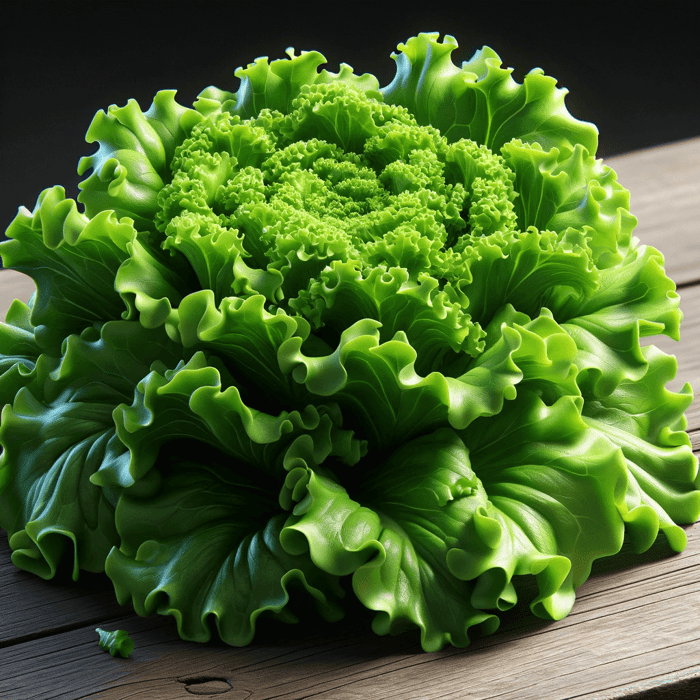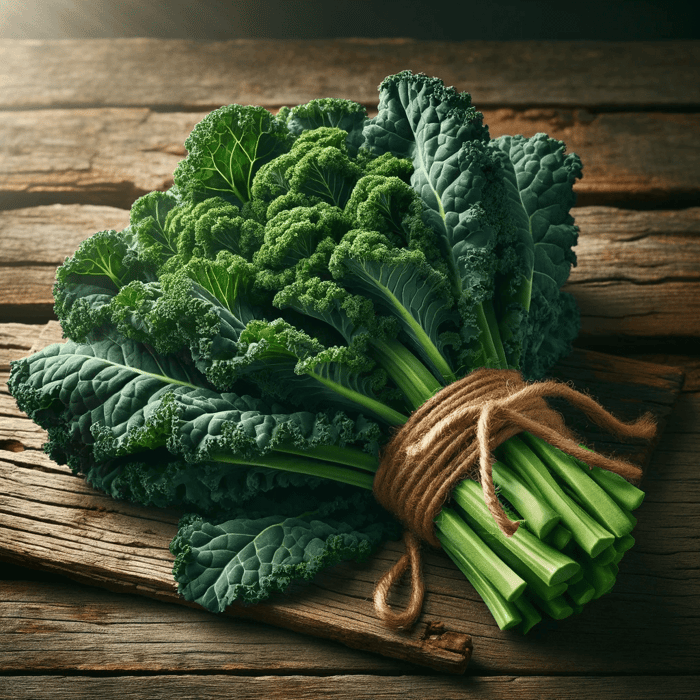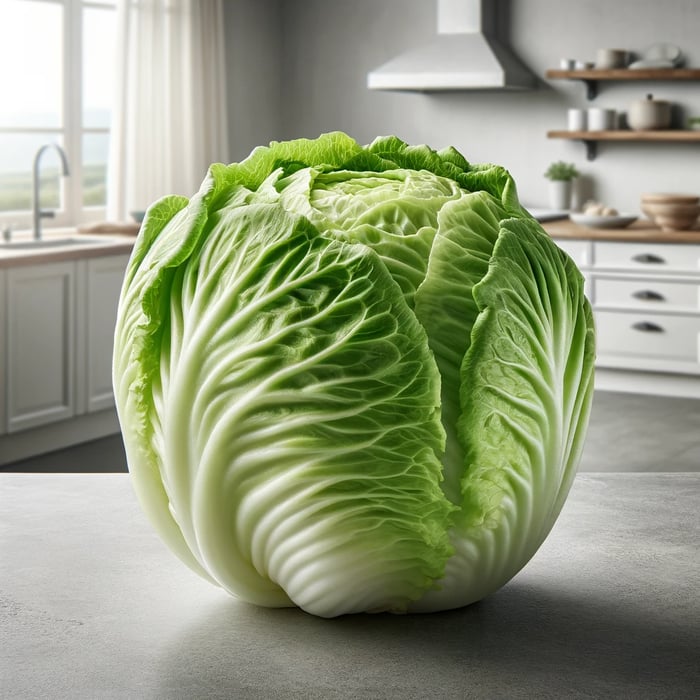Green oakleaf lettuce stands out as a remarkable variety in the world of leafy greens due to its unique characteristics and exceptional taste. This article will delve into how to grow green oakleaf lettuce from seed, exploring the various stages of cultivating this vibrant and nutritious plant. Whether you have a small garden plot or are venturing into container gardening, learning how to grow green oakleaf lettuce from seed can be a rewarding experience that allows you to enjoy its crisp leaves throughout the seasons.
Brief Overview of Oakleaf Lettuce
Oakleaf lettuce, scientifically known as Lactuca sativa var. crispa, derives its name from its distinctive leaves, which resemble oak tree foliage, with lobed edges and an elegant shape.
As a member of the lettuce family, it shares specific characteristics with other types but possesses unique qualities that set it apart. This variety has loose heads with elongated leaves ranging from light green to deep burgundy.
It is important to note that unlike other lettuces, such as romaine or iceberg, oakleaf lettuce does not form tight heads but grows in loose rosettes. Its tender and flavorful leaves have a mild yet slightly sweet taste.
- Days till maturity: Typically 45-55 days from planting.
- Planting depth: Sow seeds about ¼ inch (0.6 cm) deep.
- Plant spacing: Space plants 8-12 inches (20-30 cm) apart.
- Days to germination: Usually 7-10 days under optimal conditions.
- Indoors or Direct Sown: This can be started indoors or sown directly in the garden.
- Full Sun or Partial Shade: Prefers full sun but tolerates partial shade, especially in hot climates.
- When to harvest: Harvest when leaves are large enough to eat, usually 45-55 days after planting.
- How tall does the plant get? Oakleaf lettuce typically grows to about 6-12 inches (15-30 cm) in height.
- How wide does the plant get? The plant can spread about 8-12 inches (20-30 cm) wide.
- Native: Origin varies, but many lettuce varieties have roots in the Mediterranean region.
- Family: Belongs to the Asteraceae family, the daisy or sunflower family.
$2.49
Oakleaf Green Lettuce Seeds - Heirloom, Non-GMO, Non-Hybrid, Open-Pollinated Grow crisp, flavorful Oakleaf Green Lettuce with our premium seeds, meticulously selected for vibrant growth and delicious harvests. These heirloom, non-GMO, non-hybrid, and open-pollinated seeds ensure a reliable and sustainable choice… read moreGreen Oakleaf Lettuce Seeds

Importance of Growing Lettuce from Seed
Growing lettuce from seed offers numerous advantages over buying seedlings or mature plants. Starting with seeds gives you complete control over the entire growth process right from the beginning.
One key advantage is cost-effectiveness; purchasing packets of fresh heirloom seeds can be significantly more economical than buying individual plants at nurseries or grocery stores. Additionally, growing your lettuce allows you to choose from extensive varieties that may be less readily available than transplants.
Benefits of Choosing Oakleaf Lettuce
Choosing oakleaf lettuce has several benefits, making it an excellent choice for home gardeners and commercial growers. Firstly, oakleaf lettuce is a cool-weather crop, making it ideal for early spring and fall planting when soil temperatures are still relatively low.
Another advantage is that oakleaf lettuce grows to its full size relatively quickly, typically maturing within 45-55 days after sowing the seeds. This allows for a continuous harvest of tender leaves rather than waiting for full heads to develop, making it perfect for those who prefer to enjoy fresh, young greens throughout the growing season.
Description and Characteristics of Oakleaf Lettuce
A Leafy Treasure: Exploring the Beauty of Oakleaf Lettuce
Oakleaf lettuce, scientifically known as Lactuca sativa var. crispa, is a captivating salad green with leaves that enchant the eye and the palate.
As its name suggests, this variety of lettuce resembles an oak tree's delicate yet robust leaves. The foliage of oakleaf lettuce stands out with its distinctive lobed edges, giving it an elegant and ornamental appearance in any garden or plate.
Its leaves turn a vibrant shade of green as they mature, adding visual appeal to any dish. One remarkable characteristic of oakleaf lettuce is its ability to thrive in cool weather conditions, making it an excellent choice for early spring or fall planting.
This variety quickly establishes itself once you sow seed directly into well-prepared soil about half an inch deep. Unlike other lettuce varieties, which can turn bitter when summer arrives, oakleaf lettuce maintains its mild and slightly sweet flavor even when temperatures rise.

Nutritional Value and Health Benefits
Nourishing the Body: The Wholesome Goodness of Oakleaf Lettuce
Beyond its aesthetic appeal, oakleaf lettuce is a nutritional powerhouse that offers many health benefits to those who indulge in its crisp leaves. Rich in vitamins A and K, this leafy green helps support healthy vision and bone metabolism while providing essential antioxidants that combat free radicals in the body.
In addition to these vital nutrients, oakleaf lettuce contains folate and iron, contributing to overall well-being. What makes oakleaf lettuce genuinely remarkable is not only its nutrient content but also its low caloric value.
With only about ten calories per cup, it is an ideal choice for those watching their weight or seeking a light yet satisfying meal. The high water content and dietary fiber found in oakleaf lettuce aid digestion and promote a feeling of fullness, making it an excellent addition to any weight management plan.
Culinary Uses and Versatility in Various Dishes
The Art of Culinary Exploration: Oakleaf Lettuce as a Flavorful Canvas
Oakleaf lettuce's tender leaves offer many culinary possibilities, elevating the taste and appearance of numerous dishes. Its mild flavor makes it a versatile ingredient that pairs well with various other ingredients. Whether crafting a simple salad, assembling a sandwich, or experimenting with cooked dishes, oakleaf lettuce adds freshness and texture to your creations.
Since oakleaf lettuce grows in loose heads rather than tightly packed ones like iceberg lettuce, it allows for easy harvesting of individual leaves while keeping the rest of the plant intact. This attribute makes it perfect for continuous harvesting throughout its growth cycle.
Simply pinch off the outer leaves as they reach full size to enjoy fresh greens without uprooting the entire plant. The delicate yet sturdy nature of oakleaf lettuce lends itself beautifully to salads that require sturdy greens as a base or a colorful addition.
Its vibrant green color provides an enticing visual contrast on any plate or platter. Additionally, oakleaf lettuce can withstand light cooking methods such as wilting or quickly sautéing without losing its delightful crunch and flavor.
Oakleaf lettuce is more than just an aesthetically pleasing garden adornment; it is an edible gem with remarkable characteristics that make it worth cultivating. From its captivating appearance reminiscent of oak leaves to its numerous health benefits and culinary versatility, this leafy green has much to offer both garden enthusiasts and food lovers alike.
Buying Green Oakleaf Seeds
Gardeners Basics carries high-quality germination rates in all our seeds. Thank you for considering purchasing your green oakleaf lettuce seeds from our online seed shop.
$15.95
Fresh Lettuce Seed Assortment – 10 Heirloom Varieties, Perfect for Hydroponics, Indoor & Outdoor Gardening! Our 10 Salad Greens Lettuce Seeds Variety Pack is the ultimate selection for any home gardener or hydroponics enthusiast! This carefully curated assortment features heirloom, non-hybrid,… read moreSalad Greens Lettuce Seed Assortment | 10 Variety Pack
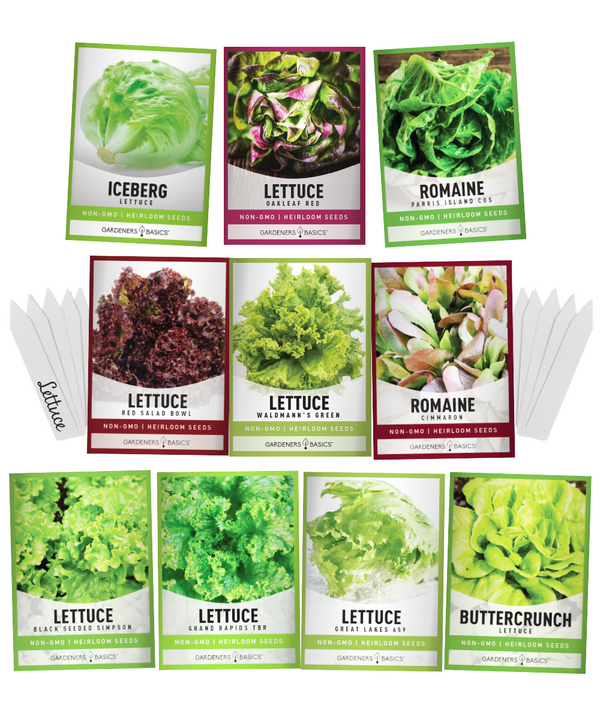
Ideal Soil Conditions for Oakleaf Lettuce Growth
A Leafy Haven: Creating the Perfect Soil
Creating the ideal soil conditions is paramount to ensure the successful growth of oakleaf lettuce. This delicate yet resilient leafy green thrives in well-draining, fertile soil.
Oakleaf lettuce prefers a slightly acidic to neutral pH range between 6.0 and 7.0, which provides an optimal environment for nutrient absorption and root development. To prepare the soil, remove any debris or weeds from the planting area to provide a clean canvas for your lettuce seeds.
Oakleaf lettuce has shallow roots, so it is crucial to cultivate the soil to a depth of approximately 6-8 inches using a garden fork or tiller. This will loosen compacted soil and improve its structure, allowing roots to penetrate easily.
Testing and Amending Soil pH, Texture, and Fertility Levels if Necessary
A Recipe for Success: Balancing the Soil's Composition
Before sowing your precious oakleaf lettuce seeds into the ground, conducting a thorough soil test is essential for understanding its composition and fertility levels. A comprehensive soil test will reveal valuable insights such as pH levels, nutrient deficiencies or excesses, and texture analysis. To test your soil's pH level accurately, use a commercially available testing kit or send samples to a local agricultural extension service laboratory.
Suppose necessary adjustments are needed due to alkaline conditions (pH above 7) or excessive acidity (pH below 6). In that case, you can add organic matter such as compost or well-rotted manure to help balance it. Analyzing your soil's texture is equally crucial since oakleaf lettuce prefers loamy soils that are well-draining yet retain enough moisture for healthy growth.
Sandy soils drain too quickly, while clay soils may become waterlogged. If soil texture could be better, amending it with organic matter like compost or peat moss can enhance its drainage and moisture-holding capacity.
Techniques for Improving Soil Drainage and Aeration
A Breath of Fresh Soil: Maximizing Oxygen Circulation
Good soil drainage and proper aeration are crucial factors in oakleaf lettuce cultivation. Excessive water retention can lead to root rot and disease, while inadequate oxygen circulation can hinder nutrient absorption and stifle plant growth.
Fortunately, there are effective techniques to improve both aspects. One technique is to create raised beds or mounds by loosening the soil and forming ridges approximately 6 inches high.
This helps improve drainage by allowing excess water to flow away easily. Additionally, raised beds warm up faster in early spring, facilitating earlier planting of oakleaf lettuce seeds.
Incorporating organic matter such as well-decomposed compost or leaf mulch into the soil can enhance its structure, promoting better aeration. Organic matter improves soil tilth by increasing pore spaces within the soil matrix, allowing roots to access vital air pockets and nutrients more efficiently.
Understanding the ideal soil conditions for oakleaf lettuce growth and implementing proper testing, amendments, drainage techniques, and aeration practices will lay a solid foundation for your lettuce garden. This attention to detail will set the stage for robust root development and yield bountiful harvests of crisp and delicious oakleaf lettuce leaves that elevate your culinary experiences.

Sowing Oakleaf Lettuce Seeds
Timing considerations for sowing seeds based on local climate
Finding the right timing to sow oakleaf lettuce seeds is crucial for successful growth. Oakleaf lettuce thrives in cool weather, so it's best to sow seeds in early spring or late summer/early fall when temperatures are moderate. Soil temperatures should be around 40-75 degrees Fahrenheit (4-24 degrees Celsius).
Sowing too early may result in poor germination while sowing too late can lead to bolted plants and bitter-tasting leaves. Consulting your local agricultural extension office or gardening resources specific to your region can provide valuable insights into the ideal sowing times.
Indoor vs outdoor sowing methods
Oakleaf lettuce can be sown indoors and outdoors, depending on your preference and available space. Indoor sowing allows for earlier starts before the last frost date, giving you a head start on the growing season.
To start seeds indoors, fill seed trays or pots with a high-quality seed starting mix, moisten it lightly, and sow the oakleaf lettuce seeds about an inch deep. Place the trays in a sunny spot or under grow lights and ensure they receive sufficient moisture by misting them regularly.
Outdoor sowing involves directly planting the seeds into prepared garden beds or containers once soil temperatures are suitable for germination. Before sowing, loosen the soil and remove any weeds or debris.
Create rows 12 inches apart if planting multiple rows. Drop the oakleaf lettuce seeds along each row approximately one inch apart.
Step-by-step guide to sowing seeds in trays or directly in the ground
For indoor sowing:
- Fill seed trays with a sterile seed starting mix.
- Moisten the mix lightly before broadcasting oakleaf lettuce seeds about an inch deep.
- Cover the sown seeds with a thin layer of the seed starting mix.
- Place trays in a warm, well-lit area or under grow lights. 5. Mist the trays regularly to maintain proper moisture levels until germination occurs.
- Once seedlings have developed their first set of true leaves, they can be transplanted into larger pots or the garden. For outdoor sowing:
- Prepare garden beds by loosening the soil and removing weeds or debris.
- Create rows 12 inches apart if planting multiple rows.
- Sow oakleaf lettuce seeds along each row about an inch apart.
- Cover the seeds with a thin layer of soil and gently pat it down.
- Water gently to ensure thorough saturation without disturbing the seeds or washing them away.
- Keep the soil moist until germination occurs, usually within 7-10 days.
Providing Optimal Growing Conditions
Sunlight requirements for healthy growth
Oakleaf lettuce requires full sun for optimal growth and development. Ensure your chosen growing location provides at least 6-8 hours of direct sunlight daily to promote vigorous plant growth, vibrant leaf coloration, and compact heads.
Watering techniques to maintain proper moisture levels
Proper watering is vital for oakleaf lettuce as it has shallow roots sensitive to drought stress and excessive moisture. Water consistently and deeply whenever the top inch of soil feels dry to the touch, aiming for about 1 inch per week through rainfall or irrigation. To prevent diseases caused by overhead watering, it is recommended to use drip irrigation or water directly at the soil level rather than sprinkling water from above.
$9.95
Grow Fresh Greens Year-Round with Our 5 Lettuce Seeds Variety Pack - Heirloom, Non-GMO, Perfect for Outdoor & Indoor Gardening Introducing our 5 Lettuce Seeds Variety Pack – the perfect addition to your garden, whether you’re a seasoned grower or… read moreLettuce Seed Assortment | 5 Variety Pack
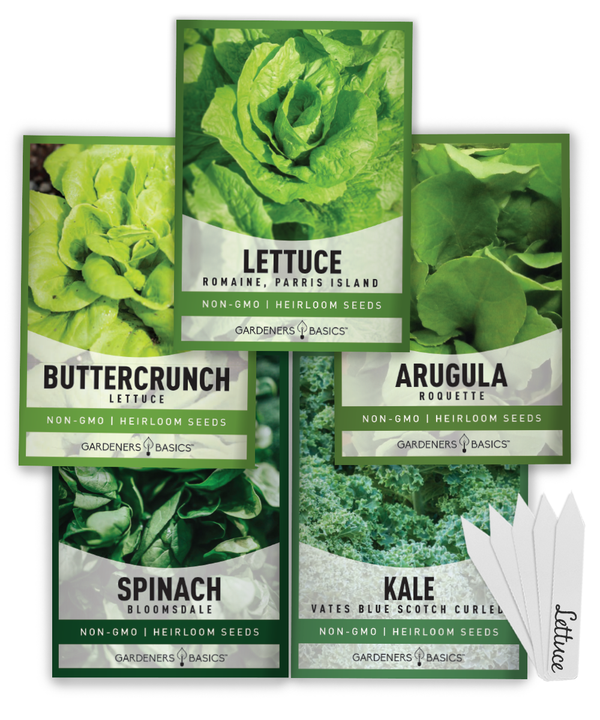
Temperature and humidity considerations
Oakleaf lettuce thrives in excellent weather conditions, with optimum growth between 55-70 degrees Fahrenheit (13-21 degrees Celsius). While it can tolerate some heat, high temperatures may cause the leaves to become bitter and develop a wilted appearance.
Maintaining moderate humidity levels around 50-60% can help prevent leaf tip burn and reduce the risk of fungal diseases. Adequate air circulation is also crucial to minimize humidity buildup, so avoid overcrowding plants and ensure proper spacing.
Thinning Seedlings & Transplanting
Importance of thinning seedlings to ensure proper spacing
Thinning seedlings is essential for oakleaf lettuce to thrive and produce full heads. Once the seedlings have grown their first true leaves, thin them out by removing weaker ones, ensuring a spacing of about 6-8 inches between plants. Thin carefully to avoid disturbing the roots of neighboring seedlings.
Guidelines for transplanting seedlings into the desired location
When transplanting oakleaf lettuce seedlings from trays or pots into their permanent growing location, follow these guidelines:
- Choose a well-prepared garden bed with loose, fertile soil.
- Dig holes are slightly more significant than each seedling's root ball.
- Carefully remove the seedling from its container without damaging the roots.
- Place each seedling in a hole, ensuring it sits at the same depth it was previously growing.
- Backfill the hole with soil and lightly firm it around the base of each plant.
- Water thoroughly after transplanting to settle the soil around the roots.
Tips to minimize transplant shock
To minimize transplant shock when moving oakleaf lettuce seedlings:
Transplant on a calm day or during cloudy periods to reduce stress on tender transplants. Avoid disturbing plant roots as much as possible during the process. Water the transplants immediately after transplanting to provide ample moisture and help them establish quickly. Consider using a shade cloth or providing temporary shade for a few days to protect young transplants from excessive sun exposure until they adjust to their new environment.
Care & Maintenance
Fertilization is needed at different stages of growth
Green oakleaf lettuce benefits from regular fertilization to support healthy growth and leaf development. Apply a balanced organic fertilizer, such as compost or well-rotted manure, before planting or as a side-dressing halfway through the growing season.
Follow package instructions for application rates based on your garden bed or container size. Monitor plant health throughout the growing season and provide additional fertilizer if signs of nutrient deficiency, such as pale leaves or stunted growth, appear.
Weed control strategies without harming the plants
Weed competition can hinder oakleaf lettuce growth and reduce yields, so it's crucial to implement effective weed control strategies. Hand-pulling weeds is always an option, but preventative measures like mulching with straw or wood chips can help suppress weed growth by blocking light access to weed seeds.
Avoid using herbicides near your lettuce plants to prevent potential damage. Regularly inspect your garden beds and remove any weeds promptly before they have a chance to become established.
Conclusion - How To Grow Green Oakleaf Lettuce From Seed
Growing oakleaf lettuce from seed is a gratifying endeavor that allows you to enjoy fresh, crisp leaves at home. By understanding timing considerations, sowing methods, providing optimal growing conditions, thinning seedlings properly, transplanting with care, and implementing adequate care and maintenance practices like proper watering and weed control, you can cultivate healthy oakleaf lettuce plants that yield bountiful harvests throughout the seasons. Embrace this journey of sowing tiny seeds that transform into vibrant green foliage. Let the flavors and textures of oakleaf lettuce adorn your table, enriching your culinary experiences with its vibrant, nutritious presence.
FAQ: How To Grow Oakleaf Lettuce from Seeds
Q1: How long does it take for oakleaf lettuce seeds to germinate?
A1: Oakleaf lettuce seeds typically germinate within 7-10 days under the right conditions, including consistent moisture and a temperature range of 60- 70°F (15-21°C).
Q2: Can I grow oakleaf lettuce in containers?
A2: Absolutely! Oakleaf lettuce is well-suited for container gardening. Ensure your container is at least 6-8 inches deep and has good drainage. Regular watering and fertilization are crucial for container-grown lettuce.
Q3: How much sunlight does oakleaf lettuce need?
A3: Oakleaf lettuce prefers full sun to partial shade. Aim for at least 4-6 hours of sunlight per day. In hotter climates, providing some afternoon shade can prevent the lettuce from bolting (going to seed) too quickly.
Q4: What is the best soil for growing oakleaf lettuce?
A4: Oakleaf lettuce thrives in well-drained, fertile soil with a pH between 6.0 and 7.0. Enriching the soil with compost or a balanced organic fertilizer can promote healthy growth.
Q5: How often should I water my oakleaf lettuce?
A5: Water your oakleaf lettuce regularly to keep the soil consistently moist but not waterlogged. You may need to water more frequently during hot or dry weather to prevent the soil from drying out.
Q6: When is the best time to harvest oakleaf lettuce?
A6: Harvest oakleaf lettuce when the leaves are large enough to eat, typically 45-55 days after planting. You can harvest individual leaves or cut the entire plant at the base.
Q7: How do I protect my oakleaf lettuce from pests?
A7: Keep an eye out for common pests like aphids and slugs. Use organic pest control methods like neem oil or insecticidal soap for aphids. For slugs, consider using diatomaceous earth or setting up slug traps.
Q8: Can I save seeds from my oakleaf lettuce for next season?
A8: Yes, you can save seeds from your oakleaf lettuce. Allow a few plants to flower and produce seeds. Once the seed heads are dry, collect the seeds and store them in a cool, dry place for the next planting season.
Q9: How do I prevent my oakleaf lettuce from becoming bitter?
A9: To prevent bitterness, avoid stress conditions like drought, excessive heat, or overcrowding. Consistent watering and harvesting before the plant bolts will help maintain a sweet flavor.
Q10: Is oakleaf lettuce a good choice for beginners?
A10: Oakleaf lettuce is an excellent choice for beginners. It's relatively easy to grow, requires minimal maintenance, and can be grown in garden beds and containers.
$29.95
Seed Safe Survival Seed Kit: The Ultimate Heirloom Collection for Self-Sufficient Gardening Introducing the Seed Safe - 35 Varieties of Heirloom Vegetable, Herb, and Fruit Seeds, the ultimate solution for gardeners who want to secure a bountiful future harvest. This… read moreSeed Safe Survival Seed Kit - 35 Variety Pack
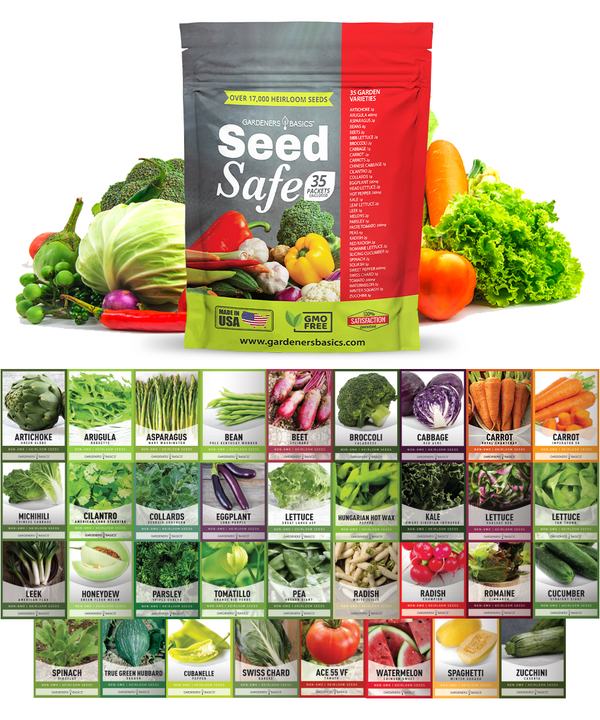
$49.95



